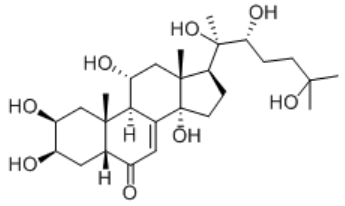turkesterone CAS#: 41451-87-0; ChemWhat Code: 100393
Identification
| Patent Information | ||
| Patent ID | Title | Publication Date |
| CN116813683 | Keemun uniflower swisscentaury root sterone compound as well as extraction method and anti-tumor application thereof | 2023 |
Physical Data
| Appearance | Off-White to Pale Yellow solid |
Spectra
| Description (NMR Spectroscopy) | Nucleus (NMR Spectroscopy) | Solvents (NMR Spectroscopy) | Frequency (NMR Spectroscopy), MHz |
| Chemical shifts | 1H | CD3OD | |
| Chemical shifts | 13C | CD3OD | |
| Chemical shifts | 1H | CD3OD | 500 |
| Chemical shifts | 13C | CD3OD | 125 |
| Chemical shifts | 13C | tetradeuteriomethanol | 125.7 |
| Chemical shifts | 1H | tetradeuteriomethanol | 500 |
| Description (IR Spectroscopy) | Solvent (IR Spectroscopy) |
| Intensity of IR bands, Bands | |
| Bands | KBr |
| Solvent (UV/VIS Spectroscopy) | Absorption Maxima (UV/VIS), nm |
| methanol | 232 |
| H2O, NaOH | 232, 290 |
Route of Synthesis (ROS)
| Conditions | Yield |
| With pyridine at 10 – 20℃; for 0.333333h; Experimental Procedure synthesis of 2,3,11,22-O-tetra-(o-methoxybenzoyl)turkesterone (7) used the general method The product was purified over a column of silica gel with elution by hexane-EtOAc (2:3) to produce the new derivative 2,3,11,22-tetra-O-(o-methoxybenzoyl)turkesterone (7, 61.0 mg, 74.8%), mp 118-119°C, Rf 0.29 (hexane-EtOAc, 4:1). | 74.8% |
Safety and Hazards
| GHS Hazard Statements | Not Classified |
Other Data
| HS Code | |
| Storage | Hygroscopic, -20°C Freezer, Under inert atmosphere |
| Shelf Life | 2 years |
| Market Price |
| Druglikeness | |
| Lipinski rules component | |
| Molecular Weight | 496.642 |
| logP | -0.192 |
| HBA | 8 |
| HBD | 7 |
| Matching Lipinski Rules | 3 |
| Veber rules component | |
| Polar Surface Area (PSA) | 158.68 |
| Rotatable Bond (RotB) | 5 |
| Matching Veber Rules | 1 |
| Use Pattern |
| Tucosone exhibits anti-inflammatory properties and is commonly used to treat conditions such as rheumatoid arthritis and osteoarthritis. Tucosone is used as a plant growth regulator to promote the growth and development of crops, enhancing yield and quality. In certain cases, Tucosone is utilized as a fruit ripening agent to promote uniform ripening and facilitate harvesting. |
Buy Reagent | |
| No reagent supplier? | Send quick inquiry to ChemWhat |
| Want to be listed here as a reagent supplier? (Paid service) | Click here to contact ChemWhat |
Approved Manufacturers | |
| Want to be listed as an approved manufacturer (Requires approvement)? | Please download and fill out this form and send back to approved-manufacturers@chemwhat.com |
Contact Us for Other Help | |
| Contact us for other information or services | Click here to contact ChemWhat |


